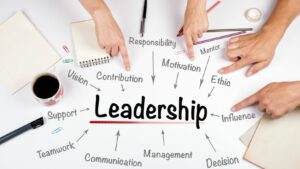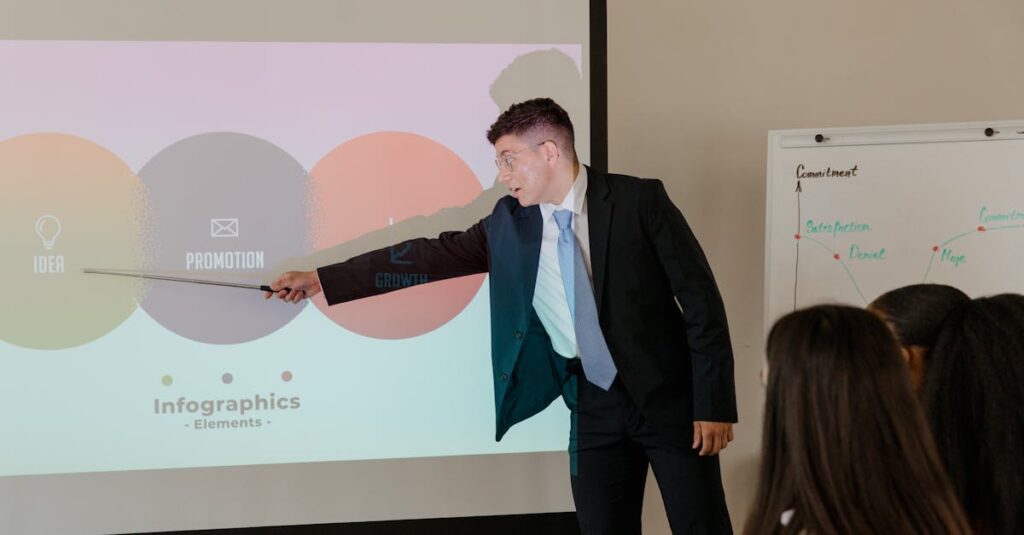In today’s fast-paced world, effective leadership is more crucial than ever. I’ve seen firsthand how a leadership style that emphasizes teamwork can transform a group into a cohesive unit. This approach not only boosts morale but also enhances productivity, making everyone feel valued and involved in the decision-making process.
When leaders prioritize collaboration, they create an environment where creativity thrives and challenges are tackled collectively. By fostering open communication and mutual respect, this type of leadership empowers team members to contribute their unique strengths. In this article, I’ll explore the key elements of team-oriented leadership and how it can elevate any organization.
Type of Leadership That Involves the Group and Promotes a Sense of Teamwork
- Focus on Collaboration: Team-oriented leadership emphasizes collaboration, encouraging brainstorming and idea sharing to enhance innovation and problem-solving.
- Open Communication: Leaders promote open lines of communication, ensuring all team members feel valued and heard, which boosts morale and trust.

- Empowerment of Team Members: Effective leaders delegate responsibilities, empowering team members to take ownership of their tasks, enhancing both motivation and accountability.
- Recognition of Achievements: Acknowledging individual and collective successes promotes a positive environment, increasing motivation and improving team dynamics.
- Enhanced Team Cohesion: Engaging team members in goal-setting fosters a sense of belonging and commitment, which strengthens group dynamics and reduces conflicts.
- Challenges of Implementation: Balancing authority and openness, as well as managing diverse opinions, are key challenges that leaders must address to maintain productivity and collaboration.
Overview of Team-Oriented Leadership
Team-oriented leadership focuses on collaboration, fostering an environment where each member actively participates in the decision-making process. This leadership style encourages open communication, ensuring that everyone feels heard and valued. By prioritizing the team’s input, leaders create a sense of belonging and ownership among group members. This participation enhances morale and leads to increased motivation towards achieving common goals.
Effective team-oriented leaders possess specific qualities that facilitate a collaborative atmosphere. They demonstrate empathy, understanding team members’ strengths and weaknesses. They actively promote trust, establishing a safe space for individuals to express ideas and concerns without fear of judgment. Leaders use feedback loops to reinforce positive contributions, helping team members grow both personally and professionally.
Key elements of team-oriented leadership include:
- Collaboration: Leaders engage team members in brainstorming sessions, promoting idea sharing to generate innovative solutions.
- Communication: Open lines of communication permit constant feedback, ensuring that all voices are heard and valued.
- Empowerment: Leaders delegate responsibilities, allowing team members to take ownership of tasks, fostering a sense of accountability.
- Recognition: Acknowledging individual and team achievements boosts motivation and strengthens group dynamics.
Through implementing these elements, team-oriented leadership enhances overall performance, aligning individual aspirations with collective goals. Organizations that adopt this approach notice higher productivity levels and improved employee satisfaction.
Characteristics of Participative Leadership
Participative leadership fosters teamwork and enhances group cohesion. This leadership style thrives on collective effort and shared decision-making among team members.
Inclusion and Collaboration
Inclusion and collaboration are core traits of participative leadership. Leaders encourage all voices to contribute, ensuring everyone feels valued. Frequent group discussions allow members to share diverse perspectives, driving innovative solutions. By promoting an inclusive environment, leaders build trust and camaraderie, significantly enhancing group dynamics. Collaborative efforts often lead to a stronger sense of responsibility towards shared goals.
Empowerment of Team Members
Empowerment of team members defines effective participative leadership. I focus on enabling individuals to take ownership of their roles and responsibilities. This involves providing opportunities for professional development and encouraging autonomy in decision-making. When team members feel empowered, they demonstrate increased motivation and commitment to their tasks. Leaders practice active listening to gauge needs, and they facilitate access to resources that support personal growth, thus enhancing overall team performance.
Benefits of Team-Oriented Leadership
Team-oriented leadership fosters an environment where collaboration thrives, leading to numerous benefits that enhance both individual and organizational success.
Enhanced Team Cohesion
Enhanced team cohesion stems from a shared sense of purpose and belonging. Team-oriented leaders engage all team members in goal-setting and decision-making, creating an inclusive culture. This invites commitment and accountability among members. Regular team-building activities and open channels of communication strengthen bonds and reduce conflicts. As trust grows, I observe how teams unite to overcome challenges, elevating overall effectiveness and performance.
Improved Problem Solving
Improved problem-solving arises from diverse perspectives in a collaborative setting. Team-oriented leaders encourage idea-sharing, allowing everyone to contribute insights. This exchange of knowledge promotes creative thinking and innovation. When facing complex challenges, collective brainstorming sessions often yield more robust solutions than individual efforts. In an environment where feedback is valued, I see team members feel empowered to propose bold ideas, driving continuous improvement and adaptability.
Challenges in Implementing This Leadership Style
Implementing a team-oriented leadership style presents specific challenges that can affect group dynamics. Addressing these challenges is essential for maximizing the effectiveness of collaboration and teamwork.
Balancing Authority and Openness
Balancing authority and openness proves challenging for team-oriented leaders. While fostering a collaborative environment, these leaders must maintain decision-making authority to ensure clarity and direction. Striking the right balance involves inviting input without losing the structured guidance necessary for progress. Leaders often face difficulties in managing expectations, as team members may desire increased autonomy while still looking for leadership assurance. Establishing clear roles and responsibilities, alongside encouraging open dialogue, helps mitigate confusion while preserving the team’s collaborative spirit.
Managing Diverse Opinions
 Managing diverse opinions represents another significant challenge in team-oriented leadership. While diverse perspectives enhance creativity, differing viewpoints can lead to conflicts or indecision. Leaders need to create a robust framework for constructive discussions, where all voices feel heard without derailing progress. Establishing ground rules for discussions and employing mediation techniques can promote a culture of respect and understanding. Encouraging team members to appreciate differing perspectives fosters inclusivity and strengthens collaboration, transforming potential conflicts into opportunities for innovative solutions.
Managing diverse opinions represents another significant challenge in team-oriented leadership. While diverse perspectives enhance creativity, differing viewpoints can lead to conflicts or indecision. Leaders need to create a robust framework for constructive discussions, where all voices feel heard without derailing progress. Establishing ground rules for discussions and employing mediation techniques can promote a culture of respect and understanding. Encouraging team members to appreciate differing perspectives fosters inclusivity and strengthens collaboration, transforming potential conflicts into opportunities for innovative solutions.
More Engaged Workforce
Embracing a team-oriented leadership style is essential for fostering a collaborative environment where everyone feels valued. By prioritizing open communication and mutual respect I can create a culture that encourages creativity and innovation. This approach not only enhances team cohesion but also drives motivation and accountability among members.
As I navigate the challenges of balancing authority with collaboration I’ll focus on establishing clear roles while promoting constructive discussions. This way I can harness diverse perspectives to turn potential conflicts into opportunities for growth. Ultimately the benefits of team-oriented leadership lead to improved performance and a more engaged workforce ready to tackle any challenge together.

